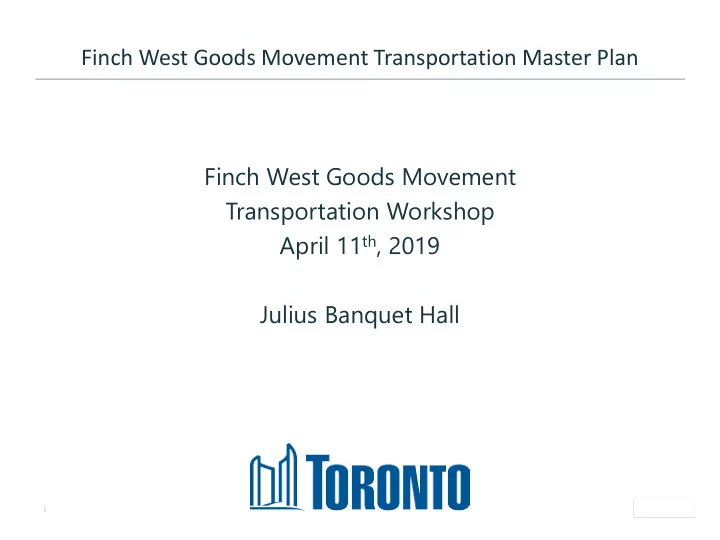

Finch West Goods Movement Transportation Master Plan Finch West Goods Movement Transportation Workshop April 11 th , 2019 Julius Banquet Hall 1
Study Area 2
Workshop Objectives • Seek the input of local businesses that depend on commercial shipping and freight delivery • Understand your transportation needs • Discuss ways to improve commercial shipping and freight transportation • Document workshop conversations to assist with long list of alternatives for Transportation Master Plan (TMP) 3
Topics for Discussion st Ro 1 st Round und – Tr Trends and Need Needs • How do you see this area changing over the next 10+ years and beyond? – How has the area been changing (e.g. types of businesses operating in the area, development pressures, etc.)? – Have these changes impacted your operations? – What are your hopes and expectations for what the area will look like in the future? 4
Topics for Discussion st Round 1 st ound – Trends ds and d Need eeds • What are some important features of your transportation needs? – How frequently do you ship/receive deliveries? – What kinds of products are you shipping and how does that impact your transportation needs (e.g. types of vehicles)? – Do you have an in-house fleet or rely on third parties? – What time of day are your operations / shipments? – What access routes do you rely on? 5
Transportation Needs (examples) Consideration Examples Depends on size and type of company – ranging from many Frequency trucks per day to occasional shipments Full truckloads, less than load (LTL), parcels, servicing, etc. Types of Shipments and Trucks 53-foot trailers, straight trucks, tankers, oversize/overweight Some vehicles have unique needs Own fleet, entirely 3 rd parties, or mix of the two Ownership Time of Day Patterns Truck trip patterns are different from passenger patterns. Truck trips typically peak around 10 – 11 a.m. Facilities differ in their hours of operation and shipping Direct access to highways is typically #1 priority Routes and Destinations Some companies use Highway 407 to avoid congestion, others avoid it because of the high tolls Businesses are welcome to share data to help us illustrate Transportation Data examples of issues or considerations 6
Topics for Discussion nd Ro 2 nd Round und – Issu Issues and Solu Solution ons • What do you consider the most important transportation / goods movement issues impacting your business (can be general or location-specific)? – What kinds of issues have you experienced? – How have these issues impacted your supply chain or operations? – What would you prioritize as the top issue for your business? 7
Topics for Discussion nd Ro 2 nd Round und – Issu Issues a and d Solu Solution ons • Are there any particular solutions that you would recommend be considered? – Proposed solutions that you have heard discussed, or new solutions that could be considered? – Should the City prioritize high-dollar, high-impact vs. low-dollar, high bang-for-the-buck? – What benefit would you see these solutions having for your business and operations? 8
Issues and Solutions (examples) Examples of Issues Examples of Solutions Short-term Congestion/delay Safety Signal-timing and traffic operations Non-signalized intersections Way-finding and signage Facility access (“final 50 feet”) Pavement marking Highway access Demand management (time of day) Street grid connectivity Medium-term Roadway geometric issues (e.g. turning Turn lanes radius) Intersection improvements Long wait times (queuing) at Curb radius / road geometry intersections Long-term Conflicts between different transportation modes New connections Poor pavement quality New roads or bridges Parking/loading areas Major interchange improvements Other… Road widenings, truck lanes 9
Workshop Structure Schedule 1 st Round Discussion – Trends and Needs 9:45 – 10:05 10:05 – 10:25 1st Round Summary 2 nd Round Discussion – Issues and Solutions 10:30 – 10:50 2 nd Round Summary 10:50 – 11:10 11:05 – 11:20 Closing Remarks 11:30 – 12:00 Study team will be available for follow-up discussions Table Facilitation Break out into small groups Facilitator: keep discussion focused on key questions Scribe: take summary notes for your table (volunteers to present) Each person can also take individual notes. Second round will include maps for any site-specific notes. 10 10
Workshop Discussions • Please take a spot at one of the tables for the next part of the workshop • City staff will scribe for the table 11
Recommend
More recommend